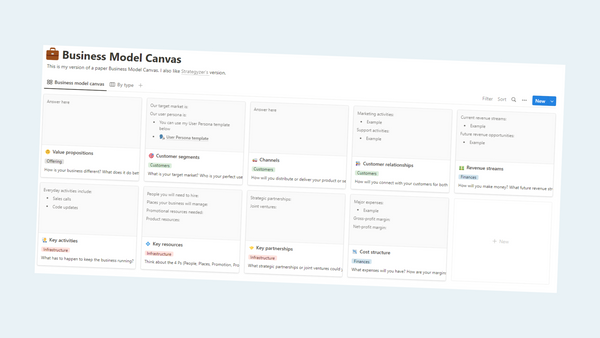I’ve spent the last three articles talking to you about various components that can help you form your business model for success.
We’ve looked at user personas (don’t forget you can get my template here), how to choose a target market, and how to research your competitors.
None of that information will do you any good unless you capture it in writing.
There a variety of documents that I help companies draft to capture their business model. I always recommend starting out with something quick and easy to complete, and then building upon that information as you learn more.
My process often looks like Business Model Canvas → Pitch Deck → MRD (Marketing Requirements Document; this is a product management document) → Full blown business plan.
Which document you need depends on the phase your business is in and the audience.
Start with a Business Model Canvas
One of the easiest, and quickest, ways to start planning out your business model is through a Business Model Canvas (BMC).
This is a one page document that is meant to capture all of the major components of a business.
A BMC has nine major components to it. Once you have these nine you have the beginnings of a business. They are:
- Value proposition - how is your business different? What does it do better than anyone else?
- Customer segments - this is where your target market and user persona information goes.
- Channels - how will you distribute or deliver your product or service?
- Customer relationships - how do you connect with your customers for both Marketing and support purposes?
- Revenue streams - this section is all about money. If you have identified more than one potential revenue stream that’s great. For example, charging an install fee for your software plus a monthly subscription fee. You can also talk about future revenue streams you see having potential.
- Key activities - what has to happen everyday for your business to be successful? Examples, include completing enough sales calls or delivering updates to your code.
- Key resources - think about the three Ps (People, Places, Promotion)
- Key partnerships - are their strategic partnerships and/or joint venture opportunities you can leverage?
- Cost structure - what expenses will you have? What do you expect your margins to look like?
What’s nice about having completed a BMC is that you end up having the beginnings of information that should go into your pitch deck, MRD, and business plan (if you need one).
Other business model templates
Although I’m a fan of the BMC model, I feel it leaves out a few key pieces. Particularly things such as your mission statement, how you will fund growth, etc. So, I created a Business Model Planner. I see it as a nice addition to the BMC or maybe even a precursor.
Speaking of funding growth, if you need capital for your business, you will need to develop a pitch deck. I have five templates you can use as a foundation.
Finally, sometimes, but not always, it makes sense to write a full-blown business plan. This is especially true if you are going after business loans through the Small Business Administration (SBA). Then it is a requirement.
